Will Allergic Skin Reactions Produce Crust On Skin
Dermatitis is inflammation of the upper layers of the skin, causing itching, blisters, redness, swelling, and oftentimes oozing, scabbing, and scaling.
-
Known causes include dry skin, contact with a particular substance, certain drugs, and varicose veins.
-
Typical symptoms include a red itchy rash, scaling, open up sores, oozing, and crusting.
-
The diagnosis is typically based on symptoms and confirmed by results of peel tests or skin samples or the presence of suspected drugs or irritants.
-
Avoiding known irritants and allergens (substances that cause an allergic reaction) reduces the risk of dermatitis.
-
Treatment depends on the crusade and the specific symptoms.
Some types of dermatitis touch on only specific parts of the body (such every bit contact dermatitis Contact Dermatitis Contact dermatitis is peel inflammation caused by straight contact with a item substance. The rash may exist itchy, is confined to a specific expanse, and often has clearly divers boundaries... read more  , including poison ivy Toxicant Ivy Poisonous substance ivy is an allergic contact dermatitis that causes a very itchy rash caused by exposure to the oil urushiol, which coats the leaves of poison ivy plants. An itchy, ruddy rash and multiple... read more
, including poison ivy Toxicant Ivy Poisonous substance ivy is an allergic contact dermatitis that causes a very itchy rash caused by exposure to the oil urushiol, which coats the leaves of poison ivy plants. An itchy, ruddy rash and multiple... read more 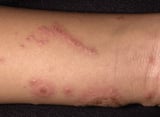 ; nummular dermatitis Nummular Dermatitis Nummular dermatitis is a persistent, ordinarily itchy rash and inflammation of the pare characterized by money-shaped spots and scale. (See as well Overview of Dermatitis.) The crusade of nummular dermatitis... read more
; nummular dermatitis Nummular Dermatitis Nummular dermatitis is a persistent, ordinarily itchy rash and inflammation of the pare characterized by money-shaped spots and scale. (See as well Overview of Dermatitis.) The crusade of nummular dermatitis... read more 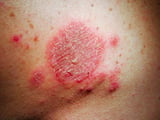 ; stasis dermatitis Stasis Dermatitis Stasis dermatitis is inflammation of the skin of the lower legs resulting from the pooling of claret and fluid. (Run into also Overview of Dermatitis.) Stasis dermatitis occurs in people who have... read more than
; stasis dermatitis Stasis Dermatitis Stasis dermatitis is inflammation of the skin of the lower legs resulting from the pooling of claret and fluid. (Run into also Overview of Dermatitis.) Stasis dermatitis occurs in people who have... read more than  ; lichen simplex chronicus Lichen Simplex Chronicus Lichen simplex chronicus is chronic, itchy inflammation of the top layer of the skin acquired past repeated scratching, rubbing, or both. Lichen simplex chronicus involves a cycle in which scratching... read more than
; lichen simplex chronicus Lichen Simplex Chronicus Lichen simplex chronicus is chronic, itchy inflammation of the top layer of the skin acquired past repeated scratching, rubbing, or both. Lichen simplex chronicus involves a cycle in which scratching... read more than 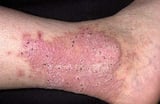 ; seborrheic dermatitis Seborrheic Dermatitis Seborrheic dermatitis is chronic inflammation that causes xanthous, greasy scales and dandruff to form on areas of the skin that have a high number of oil glands such as the scalp and confront, forth... read more
; seborrheic dermatitis Seborrheic Dermatitis Seborrheic dermatitis is chronic inflammation that causes xanthous, greasy scales and dandruff to form on areas of the skin that have a high number of oil glands such as the scalp and confront, forth... read more 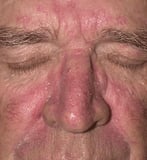 ; and manus and foot dermatitis Manus and Foot Dermatitis Hand and foot dermatitis is a chronic dermatitis characterized by red, scaly, thickened skin on the hands, the feet, or both. (See also Overview of Dermatitis.) Hand and pes dermatitis often... read more
; and manus and foot dermatitis Manus and Foot Dermatitis Hand and foot dermatitis is a chronic dermatitis characterized by red, scaly, thickened skin on the hands, the feet, or both. (See also Overview of Dermatitis.) Hand and pes dermatitis often... read more 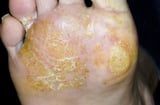 ), whereas others can occur anywhere (such as atopic dermatitis Atopic Dermatitis (Eczema) Atopic dermatitis (commonly referred to as eczema) is chronic, itchy inflammation of the upper layers of the skin that oftentimes develops in people who take hay fever or asthma and in people who... read more
), whereas others can occur anywhere (such as atopic dermatitis Atopic Dermatitis (Eczema) Atopic dermatitis (commonly referred to as eczema) is chronic, itchy inflammation of the upper layers of the skin that oftentimes develops in people who take hay fever or asthma and in people who... read more 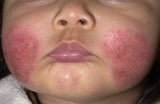 ).
).
Chronic dermatitis persists over a long menstruum of time. The hands are especially vulnerable to chronic dermatitis, considering the easily are in frequent contact with many foreign substances. Chronic dermatitis can have many different causes. Chronic scratching and rubbing because of itching frequently results in thickening of the skin (lichenification).
Dermatitis causes
-
Redness
-
Itching
-
Scaling
-
Swelling
-
Oozing
-
Crusting
-
Blisters (sometimes)
-
Thickening of peel, or lichenification (in chronic dermatitis)
Chronic dermatitis oftentimes results in thickening of pare and cracks in the skin. Whatever type of dermatitis may be complicated past an infection.
-
A medico'south examination
-
Skin or claret tests or both
-
Sometimes biopsy
Doctors base of operations the diagnosis of dermatitis on the person's symptoms and on what the rash looks like and where it appears on the body. Doctors try to decide whether the person has come in contact with an irritating substance, has an allergy, or has an infection.
-
Abstention of triggers
To reduce the risk of dermatitis, people should avoid known allergens and irritating substances (triggers).
-
Supportive care (such as moisturizers and dressings, and antihistamines for itching)
-
Topical corticosteroids or other immunosuppressive (drugs that decrease the immune system responses) creams or ointments
-
Sometimes antibiotics
-
Sometimes systemic (bodywide) immunosuppressive drugs or injections
-
Sometimes ultraviolet (UV) calorie-free therapy
CLICK HERE FOR THE Professional person VERSION

© 2022 Merck Precipitous & Dohme Corp., a subsidiary of Merck & Co., Inc., Kenilworth, NJ, Us
Source: https://www.msdmanuals.com/home/skin-disorders/itching-and-dermatitis/overview-of-dermatitis
Posted by: swartzblan1947.blogspot.com


0 Response to "Will Allergic Skin Reactions Produce Crust On Skin"
Post a Comment